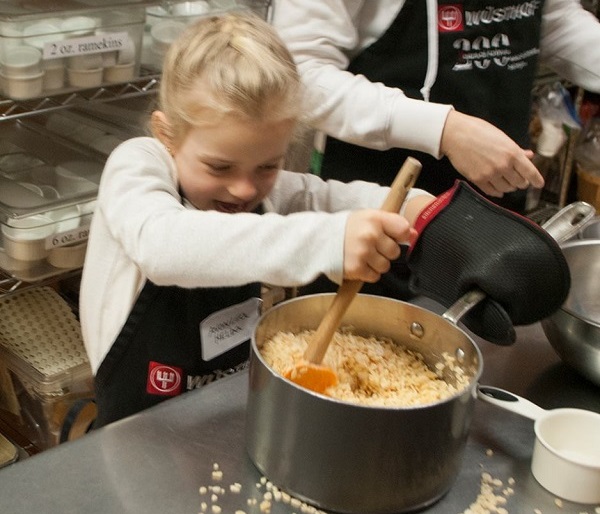
5 Pittsburgh kids cooking classes that kids are eating up
Natalie Reitz started taking cooking classes a year ago.
Since then, the 8-year-old and her mom, Jen, have completed 10 classes at Crate Cooking School.
“We’ve taken so many of the classes – pizza, Mexican Fiesta, ballpark favorites,” says Jen Reitz of Peters Twp. “She loves them. We sift through the catalog and every time we have an opportunity to take a class, we do.”
Reitz is proud of the way her daughter can now put together a complete meal of healthy food for the whole family. But she is most impressed with the confidence the classes have instilled in Natalie, even beyond the kitchen.
Natalie has learned how to read a recipe all the way through, the technical aspects of using a knife, plus math skills of fractions and timing. She knows the rules of hair back, closed-toe shoes, apron on, hands washed.
“And it’s a social aspect. The kids all work together,” Reitz says. “There is something tangible at the end, the social aspect of sharing this meal with the person they came with and all the friends they have made.”
Ready to get your junior chef started? Here are five places where kids and cooking go together like mac and cheese!
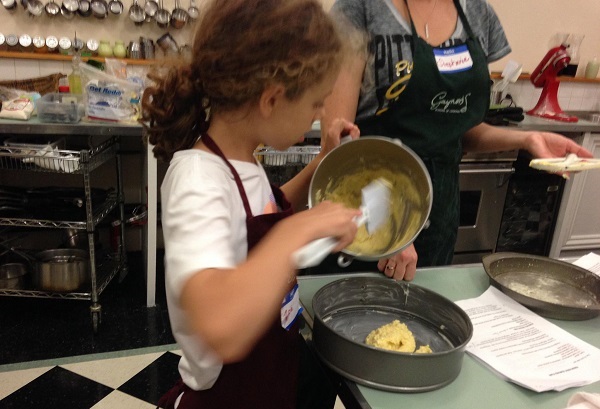
Gaynor’s Cooking School
Kids classes are a big part of Gaynor Grant’s calendar of cooking classes on the South Side. Throughout the year, Gaynor’s Cooking School schedules classes for ages from 2 to 18.
Interest in kids cooking classes continues to grow, along with the curriculum. Kids can participate in taking lessons as elaborate as making sushi, baking bread or rolling out and filling pies.
“We often get kids who are really interested, and I’m shocked by how much they know,” Grant says. “The interest level has gone up and I’m putting a lot of that down to the influence of TV.”
Mommy (or Daddy) & Me classes for preschool kids are regularly scheduled. Family Fun Nights allow the whole gang to prepare and eat a meal together.
For the younger kids, Grant says, “It’s an opportunity to realize where food comes from. Things like whipped cream doesn’t come from a can, and a bowl of soup doesn’t come from a can.”
Watch for holiday-themed classes – Scary Halloween Treats, Gingerbread Houses – and get in on the fun. Classes are planned for school holidays as well. Week-long summer camps are on the calendar, too, with the opportunity to fully immerse in, say, pastry making. Private cooking class parties are available for Scout troops, school groups and birthdays, too.
Learning health and safety – washing hands, for example – is paramount. And kids love getting hands-on with equipment like whisks and mixers.
“They love that stuff,” Gaynor says. “Even non-mechanical stuff, showing them how to use a spatula or pastry bag. They love piping. They love making a huge mess when we pipe, and we usually get more icing on the table than we do on the things we make.”
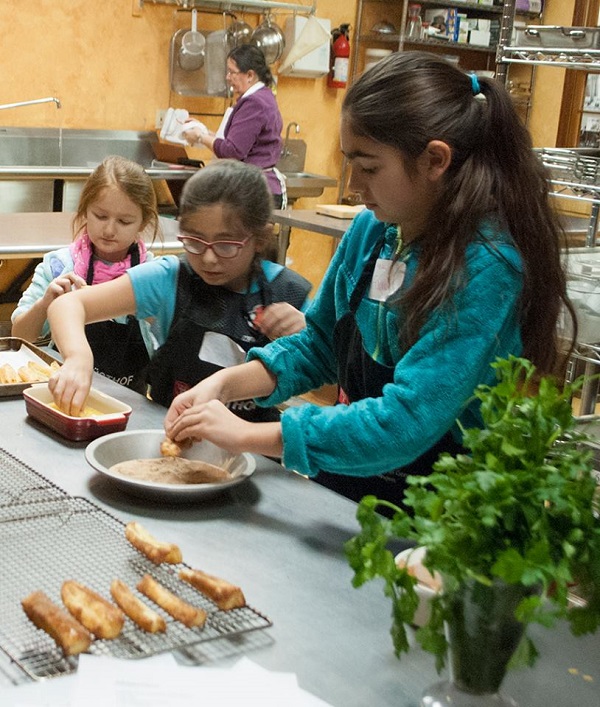
Crate Cooking School
All of the kids cooking classes at Crate include an accompanying adult. Sometimes it’s Mom or Dad, other times it’s Grandma or a favorite aunt, which can add to the attraction for these junior chefs.
“Most of them are so excited before we even get started,” says Jen Clark owner of Crate Cooking School in Scott Township. “Their eyes just light up when we talk about the menu.”
The mouth-watering variety is appealing for its flavor, as well as the skills being taught. Take Me Out to the Ballgame includes homemade soft pretzels with sweet mustard dipping sauce, hot dog sliders, oven-baked seasoned fries with homemade cheese sauce, caramel popcorn crunch and root beer float.
The Summer Picnic menu lists fruit salsa with cinnamon and sugar baked chips, skewered chicken bites with orange balsamic dipping sauce, homemade beet hummus with veggies and strawberry shortcake.
A class called Oodles of Noodles takes kids from the start of the dough to the finished pasta. A trio of sauces accompany the noodles — butter, cheese sauce, and red sauce. And for dessert, kids will make a Nutella pizza from scratch.
“We have regulars who sign up for every class they haven’t done in the past,” Clark says. “They’ll sign up for four immediately because they want to make sure they get in.”
Kids work together in different stations, adding a social facet to the culinary skills.
The grownups learn new things too, Clark says, “no matter how long they’ve been cooking. That’s why it’s always fun. There’s always something new to learn.”

Children’s Table Cooking Classes
Lisa Ferguson had a higher purpose in mind when she founded the Children’s Table 12 years ago.
“The whole purpose is to empower children in making better choices about food, whether it’s food choices while they are out or especially if they’re making it at home,” she says. “From soil to supper is our motto.”
Children’s Table has a few different components. There are Mommy and Me classes and those for older kids, as well as traveling classes hosted by Girl Scout troops, schools, and church groups. In outreach programs, under a non-profit arm, Ferguson teaches homeless kids and those in food insecure situations how to eat healthier with ingredients that are available from a food bank.
“We touch people’s lives through their bellies, but with the right foods,” she says. “Our goal is always to expose children, regardless of their socioeconomic background, to foods they might not normally eat.”
Children’s Table introduces the concept of “eating clean” and avoiding processed foods. A chicken nugget, for instance, can be made at home and be just as good, but lots healthier, than its fast food counterpart.
Some classes have themes, such as the Passport to Flavor, with classes that cover food from around the world – cilantro lime pasta salad, soba noodles with fresh vegetables, truffles related to Mayan cocoa beans, and a berry cobbler made in a mug.
“Our program integrates not only reading skills but cognitive skills and social skills,” Ferguson says. Math is a component, too, when kids are asked to convert cups to ounces, for example. Social studies is another aspect when they cover the origins of certain foods, how they got their names and why they’re popular.
The programming is all hands-on. “We don’t do demonstration because the best way for kids to learn is through actually participating and doing it themselves,” Ferguson says.
Children’s Table’s Mexican War Streets facility is currently undergoing renovations. On-site classes will resume in the fall.
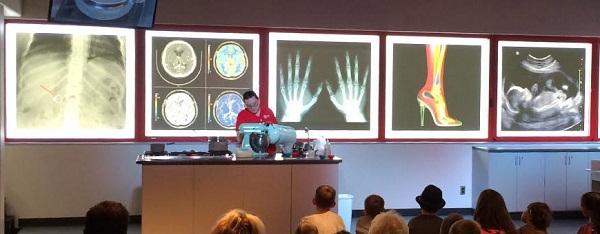
Carnegie Science Center Body Stage
Carnegie Science Center branched out from its Kitchen Science programs to go beyond mere recipes. Body Stage looks at the chemistry of food as it’s cooked, how it’s cooked – and what happens after you eat it. The live shows are as entertaining for grownups to watch and they are for the kids participating.
“The cooking shows are really popular,” says Amanda Iwaniec, technical and education manager of the Demonstration Theaters. “There’s just that curiosity about how things are made. And to take something that seems difficult and make it simple is very interesting to a kid.”
Older kids might make mozzarella cheese in a class called Say Cheese! They learn the process of cheese making from cow to table.
“You can, believe it or not, make mozzarella cheese in 30 minutes or less,” Iwaniek says. “We stretch the mozzarella live in the show and then we slice it up and allow kids to taste it.”
Participation is key in teaching the scientific concepts. In a show about ice cream, kids go on stage and are asked to dance like molecules. As the temperature cools, those molecules dance more and more slowly to demonstrate what is happening on a molecular level.
“Cooking and eating are essential for life, so it’s a really good way to introduce not only chemistry and science but your math and problem-solving skills,” Iwaniec says.
One of her favorite shows is Taste the Rainbow, in which preschool kids learn to identify edible parts of fruit and veggies, how to clean them and classify them by color. They even prepare a nutritious snack.
“Whenever you can get kids excited about food at a young age, it’s important,” Iwaniec says. “That’s when a lot of those picky habits and food aversions happen.”
The regularly scheduled shows are included with admission. Just browse the daily schedule when you check in.
Want to try it at home? Follow this link to the recipes for frozen Creamy Custard and Shake The Bag Ice Cream or fire it up with Fruit Flambe.
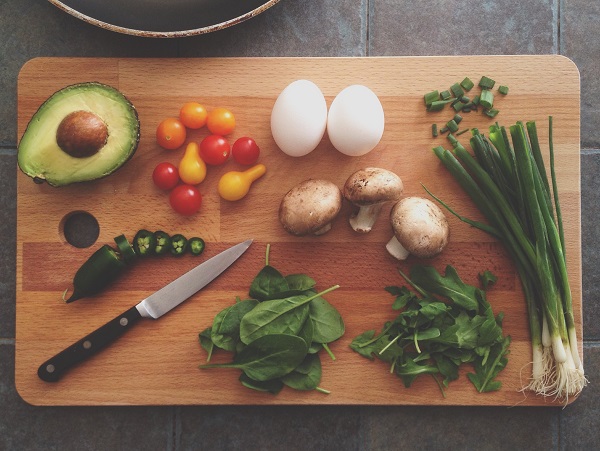
Market District Cooking School
The Market District in Robinson Township hosts Giant Eagle’s only cooking school in the Pittsburgh area. The kid-focused component fills up quickly. Each class is maxed out at 12 students, allowing one-on-one time with the chef instructors.
“Kids who come to us either have a passion for cooking, or they’ve seen it on TV with the Food Network shows, and they’ve gotten interested and want to branch out,” says Chef Ben D’Amico, product development chef for Giant Eagle and Market District stores. “TV chefs have made cooking a little more pizzazzy with cooking shows fusing entertainment for the whole family.”
For the youngest – the Small Fries, ages 5-8 – classes are geared to their level and abilities. The Peanut Butter Lovers class, for example, is both recipe themed and activity themed. They might prepare recipes like banana bread or a Thai noodle dish.
Older kids – ages 11-16 — can turn to the Novice Boot Camp, which introduces kids to basic skills. They learn not just how to use knives for chopping and mincing, but how to care for knives. Kids will learn to access pantry items to make a meal and how to substitute ingredients.
“With the boot camp, it’s the same as in culinary school but in a more compact time frame and age appropriate,” D’Amico says. “You start with the knives and then move up to simmering, braising, and move up to grilling.”
Other food-related classes in the kitchen include one on Food Etiquette and Table Manners for ages 12-17. The class shows the art of table setting and which fork to use for which dish. Basic manners are covered, plus more practical restaurant issues, such as how to order, how to ask for the check and how to calculate a tip.
Watch the Market District website for updated class schedules.